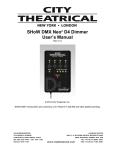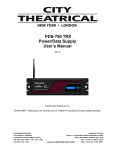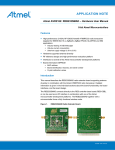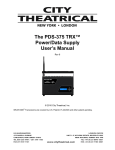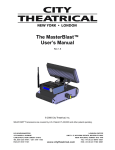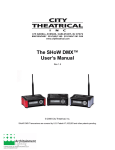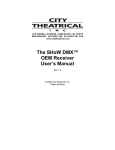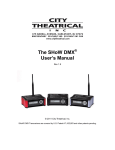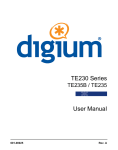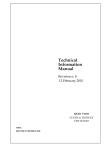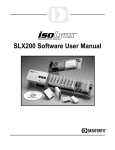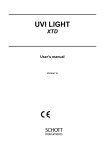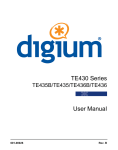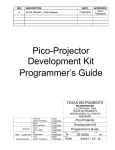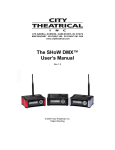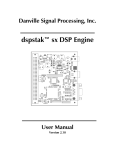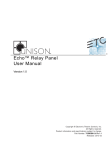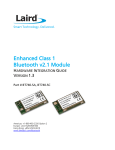Download 7400-5708 SHoW DMX Vero Net User Manual
Transcript
The 7400-5708 SHoW DMX Vero Net Transceiver User’s Manual Rev 4 © 2012 City Theatrical, Inc. SHoW DMX Vero Net Transceivers are covered by U.S. Patent # 7,432,803 and other patents pending. Radio Compliance Information .......................................................................... 3 Antennas .......................................................................................................... 4 5792 SHoW DMX Neo Radio CE Declaration of Conformity......................... 7 System Compliance Information ....................................................................... 8 Safety Notices, Ratings and Power Requirements .......................................... 8 Introduction ....................................................................................................... 10 Setting up the 7400-5708 SHoW DMX Vero Net Transceiver ......................... 11 Installation...................................................................................................... 11 Warning .................................................................................................................. 11 Important use notes .............................................................................................. 11 Grounding .............................................................................................................. 11 Mounting Bracket .................................................................................................. 11 Surface Mounting .................................................................................................. 11 Mounting Orientation ............................................................................................ 12 Pipe Mounting ....................................................................................................... 12 Cable or Conduit Entry ......................................................................................... 12 Mains Wire Installation and Termination ............................................................ 13 DMX512 Wire Termination .................................................................................... 13 Ethernet Cable entry...................................................................................... 13 Installing the Cover ............................................................................................... 14 The 7400-5708 SHoW DMX Vero Net Transceiver Settings ........................... 14 Configuration ......................................................................................................... 14 SHoW ID ................................................................................................................. 15 Classic Mode Operation ....................................................................................... 15 Classic SHoW ID Tables ....................................................................................... 15 Neo Mode Operation ............................................................................................. 17 Neo SHoW ID Tables ............................................................................................. 17 Neo Adaptive Mode Operation ............................................................................. 19 Neo Adaptive SHoW ID Table ............................................................................... 19 7400-5708 Configuration Options ................................................................ 20 Adjustable Output Power ..................................................................................... 20 Limited Burst DMX Output ................................................................................... 20 RDM Operation .............................................................................................. 20 Optional or Custom Antenna Accessories .................................................. 22 DMX512 / Art-Net / sACN Control Input ....................................................... 22 The Jese GetSet RDM Controller ................................................................. 22 Operating the Jese GetSet RDM Controller: ............................................... 23 Notes on using RDM...................................................................................... 25 Check/Change IP address .................................................................................... 26 Check/Change IP of Subnet Mask ....................................................................... 26 Check/Change IP of Gateway Address ............................................................... 26 Check/Change sACN Universe to Wireless or Wired......................................... 27 Check/Change DMX Port Direction...................................................................... 28 Check/Change Adaptive Hopping........................................................................ 29 Check/Change DHCP Mode .................................................................................. 29 Page 2 of 29 Radio Compliance Information 5792 SHoW DMX Neo™ Radio Module FCC ID: VU65792 IC ID: 7480A5792 FCC Part 15 This equipment has been tested and found to comply with the limits for a Class B digital device, pursuant to part 15 of the FCC Rules. These limits are designed to provide reasonable protection against harmful interference in a residential installation. This equipment generates, uses and can radiate radio frequency energy and, if not installed and used in accordance with the instructions, may cause harmful interference to radio communications. However, there is no guarantee that interference will not occur in a particular installation. If this equipment does cause harmful interference to radio or television reception, which can be determined by turning the equipment off and on, the user is encouraged to try to correct the interference by one or more of the following measures: • Reorient or relocate the receiving antenna. • Increase the separation between the equipment and receiver. • Connect the equipment into an outlet on a circuit different from that to which the receiver is connected. • Consult the dealer or an experienced radio/ TV technician for help. Radio Frequency Notifications FCC Notifications RF Radiation The Product is an intentional radiator of Radio Frequency (RF) energy. In order to limit RF exposure to personnel in the immediate area, the Product should be located and installed such that a separation of at least 20 centimeters is maintained between the Product’s antenna and personnel in the vicinity of the device. Modification Warning Caution: changes or modifications to this equipment, not expressly approved by City Theatrical Inc. could void the user’s authority to operate the equipment. Industry Canada Notifications This Class B digital apparatus complies with Canadian ICES-003. Operation is subject to the following two conditions: (1) this device may not cause interference, and (2) this device must accept any interference, including interference that may cause undesired operation of the device. Cet appareil numérique de la classe B est conforme à la norme NMB-003 du Canada. Product Installation and Configuration Guide © City Theatrical Inc. 2007 5792 Approved Antenna To reduce potential radio interference to other users, the antenna type and its gain should be so chosen that the equivalent isotropically radiated power (e.i.r.p.) is not more than that permitted for successful communication. This device has been designed to operate with the antennas listed below. Antennas not included in this list or having a gain greater than 5 dB are strictly prohibited for use with this device. The required antenna impedance is 50 ohms. Page 3 of 29 Antennas The model: 5792 can be configured with any one of the approved antennas listed below for fixed, point-to point one server and one client configuration. When the model: 5792 is configured for point-to-multipoint one server and multiple clients’ configuration (client’s talk to server only one at a time), client’s can use any of the approved antennas listed below and the server can use any of the approved antennas listed below with the exception of the 14dBi antenna. 5792 FCC/IC Approved Antennas: Manufacturer Model Type Connector Gain Nearson S151AH-2450S Omni whip SMA plug reverse polarity 5dBi Nearson S141AH-2450 Omni whip SMA plug reverse polarity 2dBi Nearson S131AH-2450 SMA plug reverse polarity 2dBi Nearson DG102N-2.4/5.25 SMA plug reverse polarity via provided Antenna Cable 5dBi Tekfun F40-N Omni whip Omni whip, outdoor use Omni whip, outdoor use Male N 4.5dBi Centurion WCP2400MMCX4 MMCX jack on 4” coax pigtail 2.5dBi Maxrad MP24008XFPT SMA plug reverse polarity via provided Antenna Cable 8dBi Maxrad MYP24010PT SMA plug reverse polarity via provided Antenna Cable 10dBi Maxrad MYP24014PT SMA plug reverse polarity via provided Antenna Cable 14dBi Omni whip Panel, outdoor use Yagi, outdoor use Yagi, outdoor use 5792 CE Approved Antennas: Manufacturer Model Type Connector Gain Nearson S151AH-2450S Omni whip SMA plug reverse polarity 5dBi Nearson S141AH-2450 Omni whip SMA plug reverse polarity 2dBi Nearson S131AH-2450 DG102N-2.4/5.25 SMA plug reverse polarity SMA plug reverse polarity via provided Antenna Cable 2dBi Nearson Tekfun F40-N Omni whip Omni whip, outdoor use Omni whip, outdoor use Centurion WCP2400MMCX4 Omni whip Page 4 of 29 5dBi Male N 4.5dBi MMCX jack on 4” coax pigtail 2.5dBi For installations governed by FCC and/or IC rules, any of the approved antennas listed above may be used with the SHoW DMX Vero Transceiver (please note the special installation requirements for use with the CTI # 5636 14 dBi Yagi Antenna). Please note that some of the antennas listed are intended for indoor use only. For use in locations governed by CE rules, some antenna restrictions apply. Antennas from the 5792 CE Approved Antennas meet all requirements. Contact City Theatrical for details. ETSI power settings for all 5792 SHoW DMX Neo Radio module equipped products, including the SHoW DMX Vero Transceiver, are based on use with the CTI 5630 5 dBi Omni Antenna. ETSI power and range will vary with the antenna used. Contact your dealer or City Theatrical for more information. CE Mark Conformity City Theatrical Inc. declares that this product conforms to the specifications listed in this manual, following the provisions of the European R&TTE directive 1999/5/EC: CE Mark Conformity City Theatrical Inc. declares that this product conforms to the specifications listed in this manual, following the provisions of the European R&TTE directive 1999/5/EC: City Theatrical Inc. vakuuttaa täten että dieses produkt tyyppinen laite on direktiivin 1999/5/EY oleellisten vaatimusten ja sitä koskevien näiden direktiivien muiden ehtojen mukainen. City Theatrical Inc. déclare que le produit est conforme aux conditions essentielles et aux dispositions relatives à la directive 1999/5/EC. • EN 301 489-1, 301 489-17 General EMC requirements for Radio equipment. • EN 60950 Safety • EN 300 328 Technical requirements for Radio equipment. CAUTION—This equipment is intended to be used in all EU and EFTA countries. Outdoor use may be restricted to certain frequencies and/or may require a license for operation. Contact local Authority for procedure to follow. Note: ESD precautions should be used when attaching or removing the antenna. Note: Combinations of power levels and antennas resulting in a radiated power level of above 100 mW equivalent isotropic radiated power (EIRP) are considered as not compliant with the above mentioned directive and are not allowed for use within the European community and countries that have adopted the European R&TTE directive 1999/5/EC. For more details on legal combinations of power levels and antennas, contact City Theatrical Inc. Do not use this product near water, for example, in a wet basement or near a swimming pool. Avoid using this product during an electrical storm. There may be a remote risk of electric shock from lightning. Product Installation and Configuration Guide © City Theatrical Inc. 2011 Q52 Regulatory information Radio Frequency Notifications Belgique Dans le cas d'une utilisation privée, à l'extérieur d'un bâtiment, au-dessus d'un espace public, aucun enregistrement n'est nécessaire pour une distance de moins de 300m. Pour une distance supérieure à 300m un enregistrement auprès de l'IBPT est requise. Pour une utilisation publique à l'extérieur de bâtiments, une licence de l'IBPT est requise. Pour les enregistrements et licences, veuillez contacter l'IBPT. France 2.4 GHz Bande : les canaux 10, 11, 12, 13 (2457, 2462, 2467, et 2472 MHz respectivement) sont complétement libres d'utilisation en France (en utilisation intérieur). Pour ce Page 5 of 29 qui est des autres canaux, ils peuvent être soumis à autorisation selon le départment. L'utilisation en extérieur est soumis à autorisation préalable et très restreint. Vous pouvez contacter l'Autorité de Régulation des Télécommunications (http://www.art-telecom.fr) pour de plus amples renseignements. Page 6 of 29 5792 SHoW DMX Neo Radio CE Declaration of Conformity Page 7 of 29 System Compliance Information The 7400-5708 SHoW DMX Vero Net Transceiver is ETL Listed, Conforms to UL 508A The 7400-5708 SHoW DMX Vero Net Transceiver is CE Certified Standards Applied: EN 55203-1: 2009, Environments E4 and E5 EN 55203-2: 2009, Environments E1, E2, E3, E4 EN 301 489-1 V1.8.1 EN 301 489-3 V1.4.1 EN 60950-1:2006 / A1:2010 FCC Rules, Part 15, Subpart B, Sections 15.107 and 15.109 Products Conform to CE Marking Directive 93/68/EEC All SHoW DMX Neo models are RoHS compliant Safety Notices, Ratings and Power Requirements Please read this entire manual before using your new equipment. Please keep the manual in a safe place so you can refer to it in the future as required. The SHoW DMX Neo System is intended for use only by qualified professionals. Connection, installation and hanging of this equipment must be performed in accordance with all pertinent local, regional and national safety codes and regulations. The 7400-5708 SHoW DMX Vero Net Transceiver is intended for indoor or outdoor use. The unit enclosure is rated NEMA 4 / IP66. Rated operating voltage; 100-240VAC 50/60 Hz, 1A max. This device must be provided with a 20A branch circuit breaker or equivalent suitable external disconnecting device. Maximum operating temperature: 0°C - 40°C. Warning: The 7400-5708 SHoW DMX Vero Net Transceiver must be mounted exclusively in an upright mounting position with the cable entries on the bottom and antenna connector on the top as shown in the Installation guide. See the Installation Guide in this document for details. Page 8 of 29 RF Exposure: The antenna(s) used for this transmitter must be installed to provide a separation distance of at least 20cm from all persons and must not be collocated or operating in conjunction with any other antenna or transmitter. Page 9 of 29 Introduction Thank you for using City Theatrical’s 7400-5708 SHoW DMX Vero Net Transceiver. The 7400-5708 SHoW DMX Vero Net Transceiver features include: NEMA 4 /IP 66 rated enclosure Transceiver, fully configurable for Transmit or Receive One model, FCC, IC and CE Certified New DMX synchronized hopping structure with increased interference immunity, reduced interference generation and extremely low latency Selectable true Adaptive Spread Spectrum Frequency Hopping (ASSFH) in Neo Modes Ethernet Port via RJ 45 Jack, supports multiple Ethernet show control protocols including sACN, Art-Net, and KiNet USB Port for easy future firmware updates Three Operating Modes: Neo Mode Fully configurable using RDM commands from an external RDM controller or the host. Replace missing packets with previously received data if any are lost 7mS typical latency Selectable Output power (1-72mW ETSI) Selectable Bandwidth Selectable Burst Length (when used with full frame sources) Allows for shortened frame data (less than 512 bytes from source) Enhanced RDM Proxy performance Neo-Adaptive Mode Fully configurable using RDM commands from an external RDM controller or the host. Replace missing packets with previously received data if any are lost 7mS typical latency Adaptive Hopping Selectable Output power (1-72mW ETSI) Allows for shortened frame data (less than 512 bytes from source) SHoW DMX Classic Mode Communicates with original SHoW DMX equipment DMX Synchronized Hopping User selectable Full or Limited Bandwidth User selectable Full or Limited Burst User selectable Output Power (1-72mW ETSI) Every effort has been made to anticipate your questions in this manual, but if you have any questions that are not answered here, or you want to discuss a special application, please feel free to contact us directly at City Theatrical. Page 10 of 29 Setting up the 7400-5708 SHoW DMX Vero Net Transceiver Installation Install the SHoW DMX Vero Net Transceiver in a suitable location, following the instructions below. When selecting a mounting location, note that for best results the antennas in your system must be within sight of each other. Warning To avoid electric shock, do not energize any circuits before all internal and external electrical and mechanical clearances are checked to assure that all assembled equipment functions safely and properly. Important use notes This unit must be used with voltages below 600V This unit must be installed in accordance with the National Electrical Code, ANSI/NFPA 70, where the ambient temperature does not exceed 40°C (104°F) maximum. Grounding This enclosure has been provided with a ground bond jumper for ground connection between the back box and the cover. This jumper must be installed as shown in the drawing above, using the provided hardware. Mounting Bracket The provided mounting Bracket Base can be mounted on a surface or a vertical pipe. For surface mounting, the Bracket base is provided with slots and holes suitable for #10 / M4 screws or similar fasteners. Surface Mounting Mount the Mounting Bracket Base in the desired location using four x #10 / M4 screws (by others, as above). Slide the mating Mounting Bracket (attached to the Unit) into the Mounting Bracket Base until the locking clip engages, and install the provided 8-18 x .500” SS Thread Forming Torx Button Head Security Screw, in the hole on the left side of the Bracket assembly. Page 11 of 29 Mounting Orientation The 7400-5708 SHoW DMX Vero Net Transceiver must be mounted exclusively in an upright mounting position with the cable entries on the bottom and antenna connector on the top as shown in the drawing above. Pipe Mounting The SHoW DMX Vero can also be mounted on a pipe. Attach the Mounting Bracket Base to a pipe using a stainless steel hose clamp as shown: Slide the mating Mounting Bracket (attached to the Unit) into the Mounting Bracket Base until the locking clip engages, and install the retaining screw. Cable or Conduit Entry The unit enclosure is provided with ½” NPT entry holes fitted with liquid-tight cable grips for use with outdoor use cables (by installer) for power, DMX, and Ethernet connection. The recommended torque for these cable grips is as follows: Locking Nut Sealing Nut 40‐45 inch pounds 50‐55 inch pounds Page 12 of 29 If outdoor use conduit is used instead, it is recommended that the conduit be sealed after installation to prevent moisture entry, including free air exchange, in order to minimize the chance of condensation buildup. Mains Wire Installation and Termination Install the mains cable or conduit in the entry provided as shown in the drawing below. A liquid tight cable grip is provided for use with suitable outdoor rated cable with diameter range of .170”/4,3mm - .450”/11,4mm. When cable is used, strip outer jacket 6.0”/150mm. The mains connection is a 3 pos. plug/socket type terminal block which may be disconnected for ease of assembly. Strip insulation from individual conductors .25”/7mm and terminate in the provided screw terminal socket (see illustration above) Mains terminations are ash shown and are marked on the unit. DMX512 Wire Termination The SHoW DMX Vero Net Transceiver is provided with a PCBA mount terminal block for DMX connection (see illustration above). DMX Input / Output connections are as shown and are marked on the unit. Ethernet Cable entry The unit is provided with an RJ45 Ethernet Jack for Ethernet connection. Install the Ethernet cable using the entry provided. An RJ45 Ethernet Plug must be installed on the Ethernet cable after the cable is pulled into the box, using the standard TIA-EIA T568B Page 13 of 29 pin out. Installing the Cover The 7400-5707 SHoW DMX Vero Net Transceiver has a two part cover, with the outer plastic cover connected to the inner metal cover with a hinge. Install the metal inner cover using the eight provided 6- 32 x .375” SS Truss Head Machine Screws. Hand install these screws until the screw threads are fully engaged with the mating PEM Nut, then tighten to 4 inch pounds. The outer cover is then closed and secured with the provided 8-18 x .500” SS Thread Forming Torx Button Head Security Screw, installed in the provided hole on the left side of the cover assembly. The 7400-5708 SHoW DMX Vero Net Transceiver Settings Configuration You can configure the Vero Net Transceiver’s basic operating settings using the System Settings switches shown in the detail above. Configuration switches: P5, DMX Term: DMX512 termination On or Off. Turn On for end-of-line DMX512 connection. P4, Rx/Tx: Receiver (Rx) On, or Transmitter (Tx) Off. Selects Receiver or Transmitter operation P3, Reset: On or Off. Switch On to Reset P2 Bootloader: On or Off. Sets the unit to Bootloader mode to upload and install Host and radio firmware upgrades from a connected USB Memory device. Page 14 of 29 P1 Default: On or Off. To restore the system to factory default settings: 1. Set P1 Default to On 2. Wait for PCBA LED to blink rapidly 3. Switch P1 to Off SHoW ID Like the original SHoW DMX Classic system, the SHoW DMX Neo system uses SHoW IDs as a quick way to set RF configuration options. Each SHoW ID represents a combination of one of 16 hopping patterns and one of four bandwidth settings. The Transmitter and Receiver SHoW IDs must match for the units to communicate. The SHoW DMX Vero Net Transceiver is preset at the factory with SHoW ID 201 for Adaptive Spread Spectrum Frequency Hopping and Neo Low Latency broadcast mode. SHoW ID may be set manually using the SHoW ID BCDs or using RDM. Whichever method is used last takes precedence. To set the SHoW ID manually, simply set the SHoW ID BCD Switches to the desired SHoW ID. In order to use RDM, you will also need an RDM controller or a lighting control console with a built-in RDM controller. Your new SHoW DMX Vero Net Transceiver includes CTI’s version of the Jese GetSet RDM Controller (see below for details). Classic Mode Operation In Classic Mode, the SHoW DMX Vero Net Transceiver uses the original SHoW DMX Classic broadcast format and will communicate with Classic SHoW DMX devices such as 5600/01 Transmitter, 5610/11 Receiver, etc. You can use this mode if you want to combine SHoW DMX Vero Net and Classic equipment in the same system. Classic Mode supports Adjustable Broadcast Power, Limited Bandwidth, Limited Burst, and uses 64 original SHoW IDs, providing 16 hopping patterns in each Bandwidth setting. Classic SHoW ID Tables SHoW ID 1 Classic Hopping Pattern 1 2 Classic 2 Full 3 Classic 3 Full 4 Classic 4 Full 5 Classic 5 Full 6 Classic 6 Full 7 Classic 7 Full 8 Classic 8 Full 9 Classic 9 Full Mode Page 15 of 29 Bandwidth Full 10 Classic 10 Full 11 Classic 11 Full 12 Classic 12 Full 13 Classic 13 Full 14 Classic 14 Full 15 Classic 15 Full 16 Classic 16 Full Hopping Pattern Bandwidth 1 Limited Low, Wi-Fi 1-6 SHoW ID 17 Mode Classic 18 Classic 2 Limited Low, Wi-Fi 1-6 19 Classic 3 Limited Low, Wi-Fi 1-6 20 Classic 4 Limited Low, Wi-Fi 1-6 21 Classic 5 Limited Low, Wi-Fi 1-6 22 Classic 6 Limited Low, Wi-Fi 1-6 23 Classic 7 Limited Low, Wi-Fi 1-6 24 Classic 8 Limited Low, Wi-Fi 1-6 25 Classic 9 Limited Low, Wi-Fi 1-6 26 Classic 10 Limited Low, Wi-Fi 1-6 27 Classic 11 Limited Low, Wi-Fi 1-6 28 Classic 12 Limited Low, Wi-Fi 1-6 29 Classic 13 Limited Low, Wi-Fi 1-6 30 Classic 14 Limited Low, Wi-Fi 1-6 31 Classic 15 Limited Low, Wi-Fi 1-6 32 Classic 16 Limited Low, Wi-Fi 1-6 Hopping Pattern Bandwidth 1 Limited Mid, Wi-Fi 5-9 SHoW ID 33 Mode Classic 34 Classic 2 Limited Mid, Wi-Fi 5-9 35 Classic 3 Limited Mid, Wi-Fi 5-9 36 Classic 4 Limited Mid, Wi-Fi 5-9 37 Classic 5 Limited Mid, Wi-Fi 5-9 38 Classic 6 Limited Mid, Wi-Fi 5-9 39 Classic 7 Limited Mid, Wi-Fi 5-9 40 Classic 8 Limited Mid, Wi-Fi 5-9 41 Classic 9 Limited Mid, Wi-Fi 5-9 42 Classic 10 Limited Mid, Wi-Fi 5-9 Page 16 of 29 43 Classic 11 Limited Mid, Wi-Fi 5-9 44 Classic 12 Limited Mid, Wi-Fi 5-9 45 Classic 13 Limited Mid, Wi-Fi 5-9 46 Classic 14 Limited Mid, Wi-Fi 5-9 47 Classic 15 Limited Mid, Wi-Fi 5-9 48 Classic 16 Limited Mid, Wi-Fi 5-9 Hopping Pattern Bandwidth 1 Limited High, Wi-Fi 7-11 SHoW ID 49 Mode Classic 50 Classic 2 Limited High, Wi-Fi 7-11 51 Classic 3 Limited High, Wi-Fi 7-11 52 Classic 4 Limited High, Wi-Fi 7-11 53 Classic 5 Limited High, Wi-Fi 7-11 54 Classic 6 Limited High, Wi-Fi 7-11 55 Classic 7 Limited High, Wi-Fi 7-11 56 Classic 8 Limited High, Wi-Fi 7-11 57 Classic 9 Limited High, Wi-Fi 7-11 58 Classic 10 Limited High, Wi-Fi 7-11 59 Classic 11 Limited High, Wi-Fi 7-11 60 Classic 12 Limited High, Wi-Fi 7-11 61 Classic 13 Limited High, Wi-Fi 7-11 62 Classic 14 Limited High, Wi-Fi 7-11 63 Classic 15 Limited High, Wi-Fi 7-11 64 Classic 16 Limited High, Wi-Fi 7-11 Neo Mode Operation In Neo Mode, the SHoW DMX Vero Net Transceiver uses a new broadcast format that reduces latency to ~ 7mS and provides further resistance to interference susceptibility or creation. Neo Mode supports Adjustable Broadcast Power, Limited Bandwidth, Limited Burst, and provides 64 new SHoW IDs, providing 16 hopping patterns in each Bandwidth setting. Neo SHoW ID Tables SHoW ID 101 102 103 104 105 106 Mode Neo Neo Neo Neo Neo Neo Hopping Pattern 1 2 3 4 5 6 Page 17 of 29 Bandwidth Full Full Full Full Full Full 107 108 109 110 111 112 113 114 115 116 SHoW ID 117 118 119 120 121 122 123 124 125 126 127 128 129 130 131 132 SHoW ID 133 134 135 136 137 138 139 140 Neo Neo Neo Neo Neo Neo Neo Neo Neo Neo Mode Neo Neo Neo Neo Neo Neo Neo Neo Neo Neo Neo Neo Neo Neo Neo Neo Mode Neo Neo Neo Neo Neo Neo Neo Neo 7 8 9 10 11 12 13 14 15 16 Hopping Pattern 1 2 3 4 5 6 7 8 9 10 11 12 13 14 15 16 Hopping Pattern 1 2 3 4 5 6 7 8 Page 18 of 29 Full Full Full Full Full Full Full Full Full Full Bandwidth Limited Low, Wi-Fi 1-6 Limited Low, Wi-Fi 1-6 Limited Low, Wi-Fi 1-6 Limited Low, Wi-Fi 1-6 Limited Low, Wi-Fi 1-6 Limited Low, Wi-Fi 1-6 Limited Low, Wi-Fi 1-6 Limited Low, Wi-Fi 1-6 Limited Low, Wi-Fi 1-6 Limited Low, Wi-Fi 1-6 Limited Low, Wi-Fi 1-6 Limited Low, Wi-Fi 1-6 Limited Low, Wi-Fi 1-6 Limited Low, Wi-Fi 1-6 Limited Low, Wi-Fi 1-6 Limited Low, Wi-Fi 1-6 Bandwidth Limited Mid, Wi-Fi 5-9 Limited Mid, Wi-Fi 5-9 Limited Mid, Wi-Fi 5-9 Limited Mid, Wi-Fi 5-9 Limited Mid, Wi-Fi 5-9 Limited Mid, Wi-Fi 5-9 Limited Mid, Wi-Fi 5-9 Limited Mid, Wi-Fi 5-9 141 142 143 144 145 146 147 148 Neo Neo Neo Neo Neo Neo Neo Neo 9 10 11 12 13 14 15 16 Limited Mid, Wi-Fi 5-9 Limited Mid, Wi-Fi 5-9 Limited Mid, Wi-Fi 5-9 Limited Mid, Wi-Fi 5-9 Limited Mid, Wi-Fi 5-9 Limited Mid, Wi-Fi 5-9 Limited Mid, Wi-Fi 5-9 Limited Mid, Wi-Fi 5-9 SHoW ID 149 150 151 152 153 154 155 156 157 158 159 160 161 162 163 164 Mode Neo Neo Neo Neo Neo Neo Neo Neo Neo Neo Neo Neo Neo Neo Neo Neo Hopping Pattern 1 2 3 4 5 6 7 8 9 10 11 12 13 14 15 16 Bandwidth Limited High, Wi-Fi 7-11 Limited High, Wi-Fi 7-11 Limited High, Wi-Fi 7-11 Limited High, Wi-Fi 7-11 Limited High, Wi-Fi 7-11 Limited High, Wi-Fi 7-11 Limited High, Wi-Fi 7-11 Limited High, Wi-Fi 7-11 Limited High, Wi-Fi 7-11 Limited High, Wi-Fi 7-11 Limited High, Wi-Fi 7-11 Limited High, Wi-Fi 7-11 Limited High, Wi-Fi 7-11 Limited High, Wi-Fi 7-11 Limited High, Wi-Fi 7-11 Limited High, Wi-Fi 7-11 Neo Adaptive Mode Operation The SHoW DMX Vero Net Transceiver can be configured to operate in the new Neo Adaptive (AFHSS) Mode. Neo Adaptive Mode uses an Adaptive Spread Spectrum Frequency Hopping broadcast format in which the system detects interference and adapts its frequency hopping channel set automatically to avoid it. Neo Adaptive Mode supports Adjustable Broadcast Power and provides 4 new Adaptive Mode SHoW IDs. Latency is also reduced to ~7mS max in Adaptive Mode. Neo Adaptive SHoW ID Table SHoW ID Mode 201 Neo Adaptive 202 Neo Adaptive Hopping Pattern Adaptive Adaptive Page 19 of 29 Bandwidth Full Full 203 204 Neo Adaptive Neo Adaptive Adaptive Adaptive Full Full 7400-5708 Configuration Options You can set SHoW ID either with the BCD switches as described, or via RDM. All other configurations settings must be set via RDM. Adjustable Output Power The broadcast power of the SHoW DMX Vero Net Transceiver is adjustable to allow the user to calibrate the system’s broadcast power to match the requirements of the application. Limited Burst DMX Output Limited Burst mode reduces the number of DMX channels and the amount of radio energy that is broadcast by the Transmitter. If you don’t need all 512 DMX values and you need to control the radio energy in your system as much as possible, then you can use Limited Burst to target only the DMX channels you need, and reduce your radio footprint even further. In Neo Limited Burst mode, the user may select a contiguous group of 51 slots or more DMX slots in multiples of 52 slots (51+52, 51+104, etc.). Limited Burst slot counts include: 51, 103, 155, 207, 259, 311, 363, 415, and 467. These may be assigned to any starting address that will not exceed the total 512 slot count when added to the remaining slots in the selected Burst size (e.g. with 467 slots, the highest allowed starting address is 46, as 46+466 = 512). In Classic Limited Burst Mode, burst options begin with 30 DMX channels and increase in increments of 32, so the options are 30, 62, 94, 126, etc. to 478. RDM Operation RDM stands for Remote Device Management. RDM is a lighting control protocol enhancement to DMX512 specified by PLASA (formerly ESTA); the official name is ANSI/ESTA E1.20, Entertainment Technology - Remote Device Management over USITT DMX512. Using RDM, you can select one of the 68 available Neo SHoW IDs, adjust the broadcast power, configure for limited burst transmission, edit the RDM Device Label, and enable or disable RDM traffic. The SHoW DMX Vero Net Transceiver is fully enabled as an RDM proxy system, so you can use RDM to manage your SHoW DMX Vero Net Transceiver system and any connected RDM responders that are downstream of the system. The SHoW DMX Vero Net Transceiver supports the following RDM PIDs: Get Allowed Set Allowed Reduce d RDM X X X RDM Parameter PID DISC_UNIQUE_BRANCH DISC_MUTE DISC_UN_MUTE 0x0001 0x0002 0x0003 Page 20 of 29 Comment X X X X X X X X X X X X X X X X X X X X X X X X X X X X X X X X X X X X X X X X X X X X X X X X X X X X X X X X X X X X X X X X X X X X X PROXIED_DEVICES PROXIED_DEVICE_COUNT SUPPORTED_PARAMETERS PARAMETER_DESCRIPTION DEVICE_INFO PRODUCT_DETAIL_ID_LIST DEVICE_MODEL_DESCRIPTION MANUFACTURE_LABEL DEVICE_LABEL FACTORY_DEFAULTS SOFTWARE_VERSION_LABEL DMX_PERSONALITY DMX_PERSONALITY_DESCRIPTION DMX_START_ADDRESS SENSOR_DEFINITION SENSOR_VALUE IDENTIFY_DEVICE SHOW_ID OUTPUT_POWER HOP_PATTERN BANDWIDTH RDM_TRAFFIC_ENABLE IP_ADDRESS_IN_HEX IP_SUBNET_MASK_IN_HEX IP_GATEWAY_ADDRESS_IN_HEX DHCP_MODE LATENCY DMX_RDM_ INTERLEAVE_RATIO PROXIED_DEVICES_ENHANCED ADAPTIVE_ON_OFF sACN_UNIVERSE 0x0010 0x0011 0x0050 0x0051 0x0060 0x0070 0x0080 0x0081 0x0082 0x0090 0x00C0 0x00E0 0x00E1 0x00F0 0x0200 0x0201 0x1000 0x8000 0x8001 0x8002 0x8003 0x800A 0x800C 0x800D 0x800E 0x800F 0x8019 0x801B 0x801C 0x801D 0x8F00 DMX_PORT_DIRECTION 0x8F01 Reports Category 0x0801 Repots ID 0x0604 City Theatrical, Inc. Reports CE/FCC Sets Limited Burst RSSI, Temp Instructions Page 26 Instructions Page 26 Instructions Page 26 Instructions Page 29 Instructions Page 29 Instructions Page 27 Instructions Page 28 In order to allow RDM traffic and discovery and control of connected Responders you must enable RDM Traffic (Set RDM_TRAFFIC_ENABLE to 01). Note that DMX transmission fidelity is reduced when RDM Traffic is enabled. To learn more about RDM, a good place to start is the Wikipedia article on RDM (lighting) at: http://en.wikipedia.org/wiki/RDM_(lighting) Page 21 of 29 ETSI power settings for all 5792 SHoW DMX Neo Radio module equipped products, including the SHoW DMX Vero Net Transceiver, are based on use with the CTI #5630 5 dBi Omni Antenna. ETSI power and range will vary with the antenna used. Contact your dealer or City Theatrical for more information. Optional or Custom Antenna Accessories You system may have been supplied with optional or custom antenna distribution accessories such as antennas, splitters, attenuators, lighting arrestors, or other devices. Please contact City Theatrical directly for details. DMX512 / Art-Net / sACN Control Input The SHoW DMX Vero Net Transceiver will accept DMX512, Art-Net, or sACN control input. All inputs are live and will be combined in a Highest level Takes Precedence (HTP) arrangement. The Jese GetSet RDM Controller The Jese GetSet Initial User Interface The Jese GetSet RDM Controller is provided with each Vero Net Transceiver. To get your copy, download the application from the Jese website. Page 22 of 29 Go to the Jese website (http://www.jese.co.uk/support) The Jese GetSet Website Support Page 1. Enter your Vero Net’s Serial Number and Check ID (located on the label on your Vero Net) and click Search 2. This will open a link to download the application 3. Download the application and install it 4. Connect the computer you’re using to the Vero Net via its RJ45 Ethernet connectors 5. Start the GetSet application 6. Enter the connection menu 7. Select Network as the connection type and enter the Vero Net’s IP Address. Default IP is 192.168.0.2 8. The Jese GetSet RDM controller is now ready to use Operating the Jese GetSet RDM Controller: (for detailed instructions on using Jese GetSet, download the Tri Pro User guide from the Jese website as shown above) 1. Plug your Vero Net and launch GetSet per above 2. Confirm GetSet is connected to the Vero Net ( click the Connect icon) 3. Click The Discover Icon to discover connected devices. Even if RDM is disabled in your Vero Net, GetSet will discover the Vero Net: Page 23 of 29 The Jese GetSet Initial User Interface with discovered Vero Net 4. Double click on the Vero Net line in the GetSet UI window to navigate into it, and double click on a particular RDM function to access that function: The Vero Net Jese GetSet Device Page Page 24 of 29 Select the RDM Traffic PID ($800A) and enable it to turn on RDM traffic: The Vero Net RDM Traffic Command Window 5. Now, return to the initial User Interface window and repeat Discovery to discover any Receivers in range of the Vero Net. 6. Double Click on each of the Receivers and verify each one has RDM Traffic enabled 7. Return to the initial User Interface window and repeat Discovery to discover any Responders connected to the Receivers that you have just enabled. Each Responder discovered will be available by double clicking on it in the initial User Interface window, which will produce a similar Device page with a list of available PIDs Notes on using RDM Remember that when RDM is enabled, the system uses ~ 25% of its available DMX bandwidth for RDM so DMX fidelity and refresh rate are reduced. For best DMX fidelity, disable RDM traffic from the Receivers back to the Transmitting Vero Net when you are not using RDM. You can use RDM to change SHoW IDs in connected devices. Remember that once you have changed the SHoW ID in a connected Receiver, you will lose communication with that Receiver until you change your Transmitter to the matching SHoW ID. Page 25 of 29 Check/Change IP address 1. Once GetSet is connected to the Vero Net, click on the device discovered. 2. A new window will pop-up and under Supported Parameters find $800C IP Address in Hex and double click it. The Vero Net DMX Port Direction Command Window 3. Clicking the top green arrow pointing to the Left will return the IP address your Vero Net is currently set on in Hex. Converting the number to decimal will effectively return the factory setting IP address specified in page 23. 4. Changing the IP address requires you to write the new address in Hex inside of the Set Command Hex box and click the bottom green arrow pointing to the Right in Tools.(Numbers in Hex must be two numbers or characters with a space inbetween) 5. After changing the IP Address the Vero Net will no longer work with the factory set IP Address. 6. To reconnect, in the Jese GetSet original screen click on Connection on the Top Left and click on Settings. Then Under Network Address input your new set IP Address (in Decimal). Check/Change IP of Subnet Mask 1. Changing the IPSubnet Mask follows the same steps as Changing IP address the only difference is that in step 2 you will search for $800D IP Subnet Mask in Hex and double click on this parameter. Then following the steps in changing the IP Address above will allow you to change and check your IP Subnet Mask. Check/Change IP of Gateway Address 1. Changing the IP of the Gateway Address follows the same steps as Changing IP Address also. The only difference is in Step 2 in which you will double click on Page 26 of 29 $800E IP Gateway Address in Hex under Parameter. Then following the above steps will let you change and check the IP of the Gateway Address. Check/Change sACN Universe for Wireless or Wired ports 1. Once in the The Vero Net Jese GetSet Device Page look for and double click on $8F00 sACN Univ. The Vero Net sACN Universe Command Window(Getting Data) 2. The above command window will pop up. 3. In this window you will have to supply the specific endpoint in the Get Command Hex textbox(in Hex). Endpoint 00 01 is the wireless endpoint and endpoint 00 02 is the wired sACN endpoint. 4. Pressing the top left facing green arrow in tools will give you the hex equivalent of the universe in which the wired/wireless endpoint is designated to. Page 27 of 29 The Vero Net sACN Universe Command Window(Changing Data) 5. Setting the Universe will require you to input the four digit endpoint followed by the four digits Universe you wish to use in Hex. 6. In this example we have set the Universe for the Wireless endpoint to 00 05. 7. The last two numbers in the Hex data box 01 cannot be changed. Check/Change DMX Wired Port Direction 1. In The Vero Net Jese GetSet device Page look for and double click on $8F01 DMX Port Direction. The Vero Net DMX Port Direction Command Window Page 28 of 29 2. To check the Port direction. Type in a specific endpoint (00 01 or 00 02) in the Get Command Textbox and click the top left pointing arrow in Tools. The final two digits will tell you the Port direction of the endpoint, 02 = “Out” and 01 = “In”. 3. Changing the Port Direction can only be done to the second specific endpoint 00 02. Typing the endpoint in the Set Command textbox followed by a space and 01 or 02 will change it between in and out. Check/Change Adaptive Hopping 1. Once in The Vero Net Jese GetSet Device Page, find and double click on the $801D Adaptive Hopping Parameter. 2. A Command window will appear. 3. Clicking the upper left facing arrow in Tools will return in Hex the Neo Adaptive mode. The factory setting is 00 = “Off”. 4. To Change the mode, simply enter 00(Off) or 01(On) in the Set Command Hex Textbox and click the lower right facing arrow in Tools. Check/Change DHCP Mode 1. DHCP mode allows you to change your IP either to Dynamic or Static. 2. From The Vero Net Jese GetSet Device Page, find and double click on the $800F DHCP Mode Parameter. 3. A Command window will appear. Clicking the top left facing green arrow in Tools will give you the DHCP mode in Hex. It is set to factory setting of 00(Static). 4. Changing the DHCP mode only requires placing 00(Static) or 01(Dynamic) in the Set Command Textbox and clicking the lower right facing green arrow in Tools. Page 29 of 29































